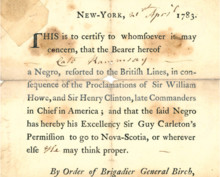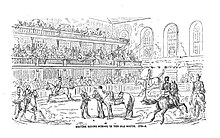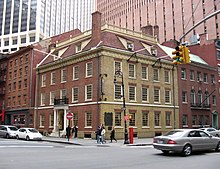| Major-General Samuel Birch | |
|---|---|
 Certificate of Freedom (Birch Certificate), (only 5 certificates remain of the 3500 issued) Certificate of Freedom (Birch Certificate), (only 5 certificates remain of the 3500 issued) | |
| Born | 21 February 1721 Gorton, England |
| Died | 1811(1811-00-00) (aged 89–90) London |
| Buried | Ardwick |
| Allegiance | United Kingdom |
| Service | British Army |
| Rank | Major General |
| Commands | 17th Regiment of (Light) Dragoons Commandant of New York City |
| Battles / wars | |
| Relations | John Birch (great great uncle) |
Major General Samuel Birch (21 February 1735 – 1811) was an officer in the British army during the American Revolution that served as the commandant of New York City. He helped free and shelter thousands of slaves as recorded in the Book of Negroes. He was the commander of the 17th Regiment of (Light) Dragoons, the only British cavalry regiment in America. He participated in most of the significant engagements in the north. He is known for leading the failed attempt to kidnap George Washington.
Career

Birch initially served in the 11th Dragoons during the Seven Years' War. Under the command of John Hale, Birch served as Captain in the newly formed 17th Regiment of (Light) Dragoons in 1759. The regiment was stationed in Scotland for three years. In 1771, as Major Birch, he fell under the command of George Preston. On 24 April 1773 he became commissioned as a Lieut. Colonel. After the war, the regiment was stationed in Ireland for 11 years.
The regiment was sent to North America in 1775, arriving in Boston, then besieged by American rebels in the American Revolutionary War. Birch fought in the Battle of Bunker Hill, a costly British victory, in June 1775. On 27 October 1775, Birch and his regiment famously rode their horses to disrupt the gatherings of patriots in Boston’s Old South Meeting House. The regiment was part of the evacuation of Boston in 1776 and was withdrawn to Halifax for two months.
In June 1776, Birch was given command of the regiment and arrived at Staten Island, attached to the Highland Brigade under Brigadier-General Sir William Erskine. He fought at the Battle of Long Island in August 1776 at the Battle of White Plains in October 1776 and at the Battle of Fort Washington in November 1776. It was in action again at the Battle of Forts Clinton and Montgomery in October 1777, the Battle of Crooked Billet in May 1778 and the Battle of Barren Hill later that month. He then led the 2nd Division in the Battle of Monmouth.

In 1780, serving under the command of Colonel George Preston, Birch became commandant of New York City.

General Guy Carleton appointed Birch to determine which Blacks had earned their freedom as Loyalist soldiers. These meetings became known as "The Birch Trials" and they happened at Fraunces Tavern, NYC every Wednesday from April to November of 1783. Its members judged each black on the testimony that he/she offered as evidence of loyal service. There were 3,500 freed slaves.
On August 21, 1783, Birch left New York. (General Thomas Musgrave would sign his name to more than 340 additional emancipation certificates before the last Black Loyalist had set sail for Nova Scotia on November 30, 1783.) After the war, the regiment returned to Ireland (1784). They were under the command of Thomas Gage (1783–1784).
He remained in the 17th Regiment as a Lieutenant Col. in 1785 – 1793 under Col. Thomas, Earl of Lincoln. The Regiment was posted to Jamaica and he became a Major General (1790). For his last year with the regiment, 1794, he was under the command of Col Thomas, Duke of Newcastle. He was the last surviving soldier of those who had originally established the regiment 35 years earlier (1759–1794).
Family
Birch's great grandfather was Major Samuel Birch and his great, great uncle was Col. John Birch.
Birch was the son of Samuel Birch (1690–1757) of Lower Ardwick and Elizabeth Hill (1704–1782) of Manchester. Samuel Sr. was a High Sheriff of Lancashire he also donated the site for the St. Thomas Chapel, Ardwick (1740) (present-day St. Thomas Centre). Birch was baptised at Gorton Chapel (1735). His father's will left the manors of Upper and Lower Ardwick to his son Thomas, who then willed them to his brother Samuel. Samuel owned them for 15 years (1780–1795). In 1795, Birch sold his properties to William Horridge, which was legally contested (Watson v. Birch). With the sale of these properties and the lack of hiers, one commentator wrote,
- "And so the story of the vicissitudes of the ancient owners of the lands of Ardwick closes. The old family of the Birches seem to have quite disappeared from the seat and scene of their past prosperity. Captains and major-generals and high-sheriffs, men of a renown larger than their own lands, wider than the great country wherein they formerly flourished! "Sic transit gloria mundi."
The sale of the estates in 1795 is that last known record of Birch other than that he died January 1811 at age 76, without marrying or having children. He lived the last fifteen years of his life in Ludgate Hill, London, but the location of his gravestone is unknown.
Legacy
- Birch is the namesake of Birchtown, Nova Scotia and Birchtown, Guysborough County, Nova Scotia
- Namesake of Birch Street, Digby, Nova Scotia
See also
Links
Notes
- Samuel Birch of Ardwick. Baptised April 30, 1730; brother Thomas died 1781. Both brothers died issueless.
References
Texts
- Cannon, Richard (1841). Historical Record of the Seventeenth Regiment of Light Dragoons, Lancers: Containing an Account of the Formation of the Regiment in 1759 and of Its Subsequent Services to 1841. John W. Parker.
- A history of the ancient chapel of Birch, in Manchester parish, including a sketch of the township of Rusholme, for the convenience of which township the chapel was originally erected: together with notices of the more ancient local families, and particulars relating to the descent of their estates by Booker, John
Notes
- Cannon, p. 24
- ^ John William Fortescue (20 May 1895). "A History of the 17th Lancers (Duke of Cambridge's Own)". Macmillan and co. Retrieved 20 May 2019 – via Internet Archive.
- says, Vince Furnier (15 August 2017). "The Plot to Kidnap Washington". HistoryNet. Retrieved 20 May 2019.
- Brad Meltzer. The First Conspiracy: The Secret Plot to Kill George Washington
- McBurney, Christian (16 May 2016). Abductions in the American Revolution: Attempts to Kidnap George Washington, Benedict Arnold and Other Military and Civilian Leaders. McFarland. ISBN 9781476624297. Retrieved 20 May 2019 – via Google Books.
- "Brig. Gen. Samuel Birch and the Ambiguity of the American Revolution". washingtonpapers.org. Retrieved 29 December 2023.
- Cannon, Richard (1841). Historical Record of the Seventeenth Regiment of Light Dragoons-- Lancers: Containing an Account of the Formation of the Regiment in 1759, and of Its Subsequent Services to 1841. J.W. Parker. Retrieved 20 May 2019 – via Internet Archive.
birch.
- Cannon, p. 12
- Almack, Edward (29 December 1908). "The history of the Second dragoons : "Royal Scots greys"". London : Retrieved 29 December 2023 – via Internet Archive.
- "17th Regiment of Light Dragoons". www.replications.com. Retrieved 20 May 2019.
- Cannon, p. 15
- ^ "Brig. Gen. Samuel Birch and the Ambiguity of the American Revolution". Retrieved 20 May 2019.
- "Collections of the Massachusetts Historical Society". Boston : The Society. 29 December 1792. Retrieved 29 December 2023 – via Internet Archive.
- "The British in Boston, being the diary of Lieutenant John Barker of the King's own regiment from November 15, 1774 to May 31, 1776; with notes by Elizabeth ..." HathiTrust. Retrieved 29 December 2023.
- "March 17th, 1876 : Celebration of the Centennial Anniversary of the Evacuation of Boston by the British Army, March 17th, 1776 : Reception of the Washington Medal : Oration Delivered in Music Hall, and a Chronicle of the Siege of Boston". order of the City Council. 29 December 1876. Retrieved 29 December 2023 – via Google Books.
- Cannon, p. 16
- Cannon, Richard (17 March 2018). "Historical record of the Seventeenth Regiment of Light Dragoons—Lancers: containing an account of the formation of the regiment in 1759 and of its subsequent services to 1841". Harrison and Co. Retrieved 20 May 2019 – via Google Books.
- "Thomas Jones (1731–1792). How the British Troops Protected the Loyalists. Stedman and Hutchinson, eds. 1891. A Library of American Literature: An Anthology in 11 Volumes". www.bartleby.com. Retrieved 20 May 2019.
- Huntington (N.Y.) (20 May 1889). "Huntington Town Records, Including Babylon, Long Island, N.Y.: 1776–1873". "Long Islander" Print. Retrieved 20 May 2019 – via Google Books.
- Brienza, Laura (1 September 2016). New York's Historic Restaurants, Inns & Taverns: Storied Establishments from the City to the Hudson Valley. Rowman & Littlefield. ISBN 9781493024353. Retrieved 20 May 2019 – via Google Books.
- "UELAC.org – Loyalist Trails newsletter Online edition 2015 Archive". www.uelac.org. Retrieved 20 May 2019.
- "UELAC.org – Loyalist Trails newsletter Online edition 2018 Archive". www.uelac.org. Retrieved 20 May 2019.
- Cannon, p. 34
- "The New Jamaica Almanack, and Register: Calculated to the Meridian of the Island for the Year of Our Lord 1791. ..." David Dickson. For Thomas Stevenson & Company, Kingston. 1791. Retrieved 20 May 2019 – via Google Books.
- Fortescue, Sir John William (20 May 1895). "A History of the 17th Lancers: 1759–1894, by the Hon. Sir John Fortescue". Macmillan & Company, Limited. Retrieved 20 May 2019 – via Google Books.
- Fortescue, John William (1895). "A History of the 17th Lancers (Duke of Cambridge's Own)". Macmillan and co. p. 191.
- A history of the 17th Lancers (Duke of Cambridge's own). Macmillan and co. 21 July 1895.
- "Geograph:: Memorial of Colonel John Birch (Weobley) (C) Fabian Musto". www.geograph.org.uk. Retrieved 20 May 2019.
- ^ "Remains, Historical and Literary, Connected with the Palatine Counties of Lancaster and Chester". Chetham Society. 20 May 2019. Retrieved 20 May 2019 – via Google Books.
- "St Thomas Centre -". www.stthomascentre.org.uk. Retrieved 20 May 2019.
- "Lancashire OnLine Parish Clerk Project – District of Manchester". www.lan-opc.org.uk. Retrieved 20 May 2019.
- "Remains, Historical and Literary, Connected with the Palatine Counties of Lancaster and Chester". Chetham Society. 20 May 2019. Retrieved 20 May 2019 – via Google Books.
- ^ Smallwood, Marilu Burch (20 May 2019). "Birch, Burch family in Great Britain and America". Adel, Ga., Press of the Patten Publishers . Retrieved 20 May 2019 – via Internet Archive.
- "A Short History of Gorton Chapel". www.brookfieldchurch.altervista.org. Retrieved 20 May 2019.
- "A History of the County of Lancaster". London: Victoria County History. 1911.
- "The Admission Register of Manchester School" (PDF). p. 27.
- news, Manchester city (20 May 1880). City news notes and queries [afterw.] Manchester notes and queries. Ed. by J.H. Nodal. Vol.1–8 [issued in 33 pt. Wanting pt.1,5]. p. 271. Retrieved 20 May 2019 – via Internet Archive.
manors of Upper and Lower Ardwick birch.
{{cite book}}:|last=has generic name (help) - Latin translation: "Thus passes the glory of the world".
- Britain, Great (20 May 2019). "The London Gazette". T. Neuman. Retrieved 20 May 2019 – via Google Books.